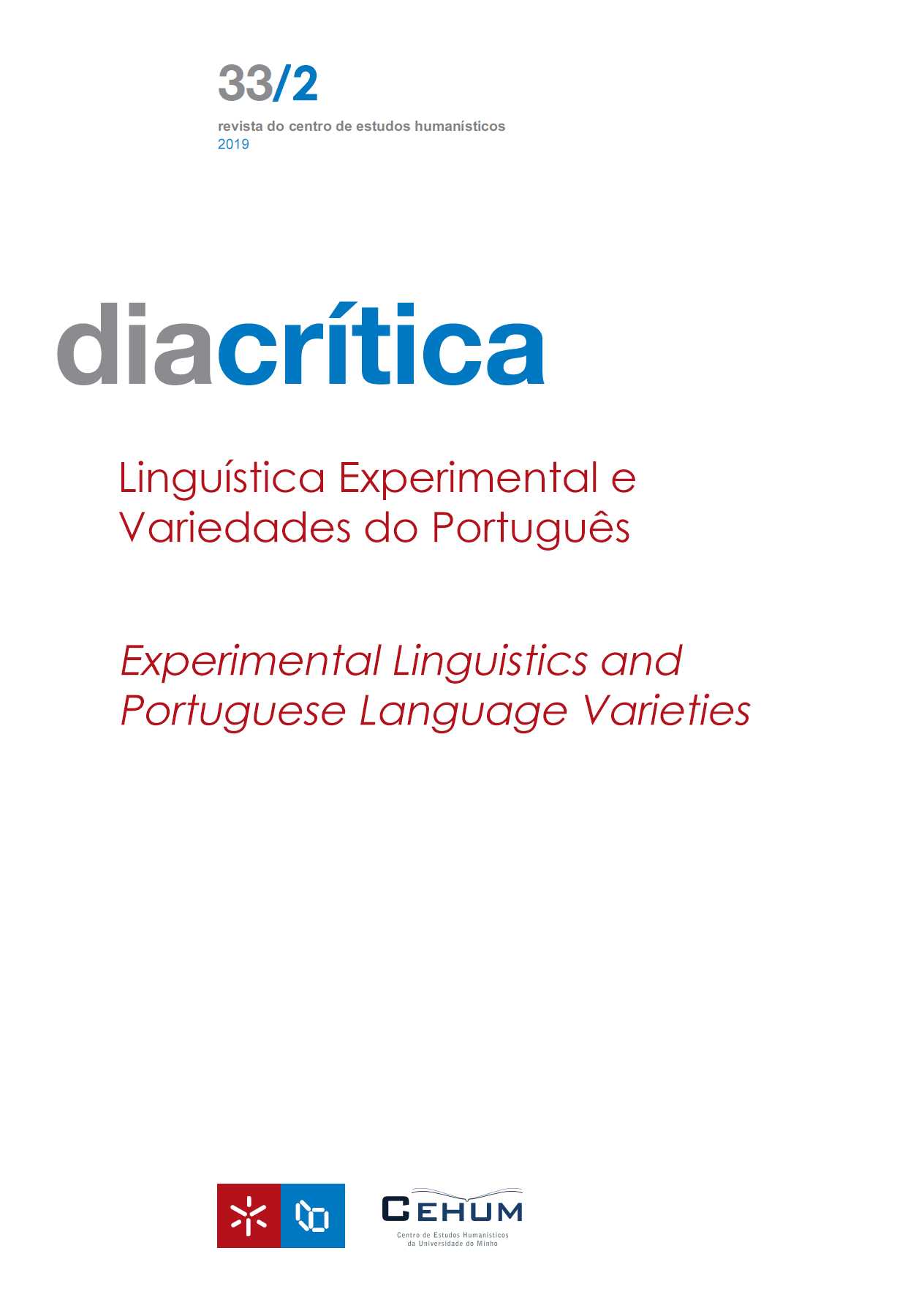Learning parts-of-speech through distributional analysis. Further results from brazilian portuguese
DOI:
https://doi.org/10.21814/diacritica.5063Keywords:
Language acquisition, Part-of-speech learning, Distributional analysis, Cognitive modellingAbstract
A child learning a language has to figure out what the syntactic, or part-of-speech, categories in her language are and assign words to one or more of them. The question we aim to answer here is how much of this learning can be accomplished through the distributional analysis of utterances. To this end, a reimplementation of Redington, Chater and Finch (1998) computational model was conducted and applied to Brazilian Portuguese input data, obtained from publicly available corpora of both child-directed and adult-to-adult speech. Results from all experiments are presented and discussed. These experiments investigate many variables and aspects involved in this learning task: types of distributional contexts, the number of target and context words, the value of distributional information for different categories, corpus size, etc. A comparison between child-directed speech and adult-to-adult speech is also carried out. In general, our results support Redington et al.’s (1998), although we find some possibly important, and maybe contradictory, differences. We also evaluate the cosine metric, comparing it with performance obtained with the Spearman rank correlation metric used in Redington et al.’s (1998) study. The latter seems to produce better performance. In this paper we focus on a quantitative analysis of our results.
References
Baroni, M. &Lenci, A. (2010). Distributional memory: A general framework for corpus-based semantics. Computational Linguistics, 36(4), 673–721. DOI: https://doi.org/10.1162/coli_a_00016
Bernal, S., Lidz, J., Millotte, S.& Christophe, A. (2007). Syntax constrains the acquisition of verb meaning. Language Learning and Development, 3, 325–341. DOI: https://doi.org/10.1080/15475440701542609
Berwick, R. C., Pietroski, P., Yankama, B. & Chomsky, N. (2011). Poverty of the stimulus revisited. Cognitive Science, 35, 1207–1242. DOI: https://doi.org/10.1111/j.1551-6709.2011.01189.x
Brown, R.W. (1957). Linguistic determinism and the part of speech. Journal of Abnormal & Social Psychology, 55(1), 1–5. DOI: https://doi.org/10.1037/h0041199
Clark, A. (2003). Combining distributional and morphological information for part of speech induction. In Proceedings of the Tenth Conference on European Chapter of the Association for Computational Linguistics –Volume 1, EACL’03(pp.59–66).Stroudsburg, PA, USA:Association for Computational Linguistics. DOI: https://doi.org/10.3115/1067807.1067817
Faria, P. (2019). The Role of Utterance Boundaries and Word Frequencies for Part-of-speech Learning in Brazilian Portuguese Through Distributional Analysis. In Proceedings of the Workshop on Cognitive Modeling and Computational Linguistics(NAACL’19), 152–159. DOI: https://doi.org/10.18653/v1/W19-2917
Faria, P. &Ohashi, G. O. (2018). A aprendizagem distribucional no português brasileiro: um estudo computacional. Revista LinguíStica,14(3),128–156. DOI: https://doi.org/10.31513/linguistica.2018.v14n3a21419
Frank, M. C. (2011). Computational models of early language acquisition. CurrentOpinion in Neurobiology,21(3), 381–386. https://doi.org/10.1016/j.conb.2011.02.013. DOI: https://doi.org/10.1016/j.conb.2011.02.013
Galves, C.,Andrade, A. L. de & Faria, P. (2017). Tycho Brahe Parsed Corpus of Historical Portuguese. <http://www.tycho.iel.unicamp.br/corpus/en/>. DOI: https://doi.org/10.1075/lv.00004.gal
Harris, Z.S. (1954). Distributional structure. Word, 10(2-3),146–162. DOI: https://doi.org/10.1080/00437956.1954.11659520
Kaplan, F., Oudeyer, P.-Y. & Bergen, B. (2008). Computational models in the debate over language learnabiliy. Infant and Child Development, 17(1), 55–80. DOI: https://doi.org/10.1002/icd.544
Landau, B.&Gleitman, L. R. (1985). Language and experience: evidence from the blind child. Harvard University Press, Cambridge, MA.
Lenci, A. (2018). Distributional models of word meaning. AnnualReview ofLinguistics, 4,151–171. DOI: https://doi.org/10.1146/annurev-linguistics-030514-125254
Hirsh-Pasek, K., Kemler Nelson, D. G., Jusczyk, P. W., Cassidy, K. W., Druss, B. & Kennedy, L. (1987). Clauses are perceptual units for young infants. Cognition, 26(3), 269–286. DOI: https://doi.org/10.1016/S0010-0277(87)80002-1
MacWhinney, B. (2000). The CHILDES Project: Tools for analyzing talk, third edition. Lawrence Erlbaum Associates, Mahwah, NJ.
Mikolov, T., Sutskever, I., Chen, K., Corrado, G. & Dean, J. (2013). Distributed representations of words and phrases and their compositionality. In Proceedings of the 26th International Conference on Neural Information Processing Systems –Volume 2, NIPS’13(pp.3111–3119).Lake Tahoe, NV, USA:Curran Associates Inc.
Pennington, J., Socher, R. & Manning, C. D. (2014). Glove: Global vectors for word representation. EMNLP, 14, 1532–1543. DOI: https://doi.org/10.3115/v1/D14-1162
Pullum, G. K. (1996). Learnability, hyperlearning, and the poverty of the stimulus. In Proceedings of the Twenty-Second Annual Meeting of the Berkeley Linguistics Society: General Session and Parasession on The Role of Learnability in Grammatical Theory(pp.498–513). Berkeley, California: Berkeley Linguistics Society. DOI: https://doi.org/10.3765/bls.v22i1.1336
Redington, M., Chater, N. & Finch, S. (1998). Distributional information: A powerful cue for acquiring syntactic categories. Cognitive Science, 22(4), 425–469. DOI: https://doi.org/10.1207/s15516709cog2204_2
Seidenberg, M. S. (1997). Language acquisition and use: Learning and applying probabilistic constraints. Science, 275(14), 1599–1603. DOI: https://doi.org/10.1126/science.275.5306.1599
Snow, C. E. (1977). The development of conversation between mothers and babies. Journal of Child Language, 4, 1–22. DOI: https://doi.org/10.1017/S0305000900000453
Tomasello, M. (1995). Language is not an instinct. Cognitive Development, 10, 131–156. DOI: https://doi.org/10.1016/0885-2014(95)90021-7
Turney, P. D. & Pantel, P. (2010). From frequency to meaning: Vector space models of semantics. Journal of Artificial Intelligence Research, 37(1), 141–188. DOI: https://doi.org/10.1613/jair.2934
Wintner, S. (2010). Computational Models of Language Acquisition. InA. Gelbukh (Ed.),Proceedingsof the 11th international conference on Computational Linguistics and Intelligent Text Processing(CICLing'10)(pp. 86–99).Berlin, Heidelberg: Springer-Verlag. http://dx.doi.org/10.1007/978-3-642-12116-6_8 DOI: https://doi.org/10.1007/978-3-642-12116-6_8
Yang, C.(2002). Knowledge and learning in natural language. Oxford: Oxford University Press.
Yang, C. (2012).Computational models of syntactic acquisition. Wiley Interdisciplinary Reviews: Cognitive Science, 3,205–213. http://dx.doi.org/10.1002/wcs.1154 DOI: https://doi.org/10.1002/wcs.1154
Downloads
Published
How to Cite
Issue
Section
License
Copyright (c) 2023 Pablo Faria

This work is licensed under a Creative Commons Attribution-NonCommercial 4.0 International License.










